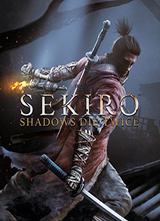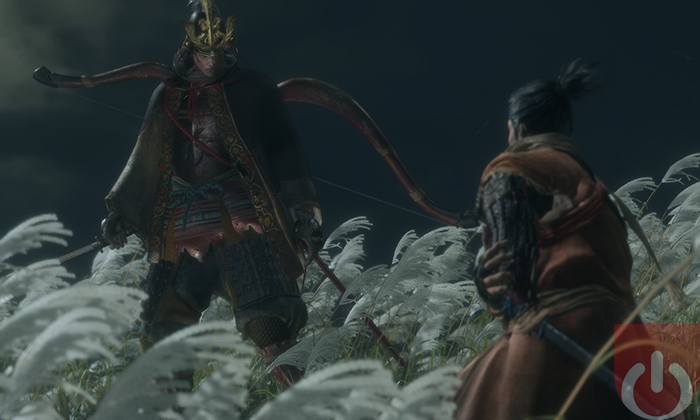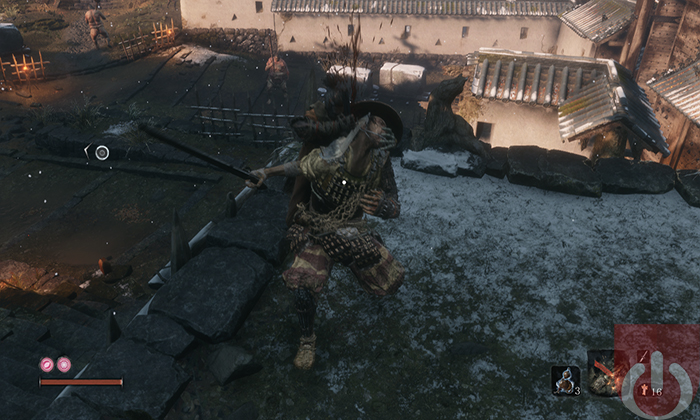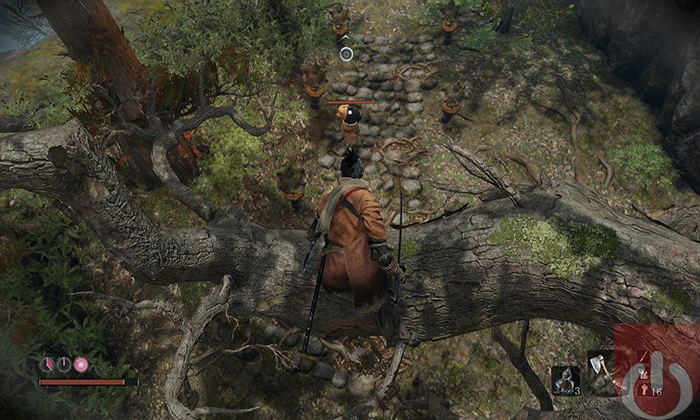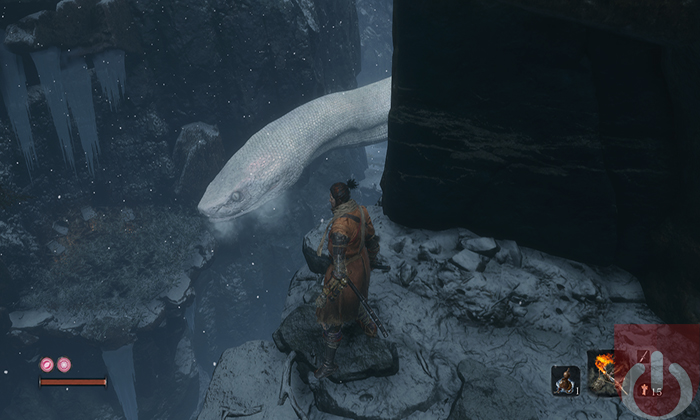Sekiro: Shadows Die Twice
Sekiro: Shadows Die Twice isn’t what I thought it would be. It’s definitely a FromSoftware title. By that, I mean, it managed to frustrate the hell out of me on many occasions. It also proved to be a slight departure from the norm; a Soulsborne game that works, despite not sharing some of the notable gameplay mechanics these titles are known for.
Sekiro follows the exploits of a shinobi named Wolf and Kuro, the young lord he’s assigned to protect. Set in a re-imagined version of 1500s Sengoku Japan, Kuro’s world is plagued with conflict as rival clans waged war over territory. This makes Wolf ever vigilante in his assignment. Assassins are everywhere. What he doesn’t know is that his lord isn’t being hunted because of his title. As the descendant of an ancient bloodline, Kuro can grant immortality to anyone of his choosing. This special ability makes him the target of the prevailing Ashina clan. Ever since their enemies learned that the head of the clan had fallen ill, they’ve struggled to maintain control. His impending death could be averted however, if his heirs are able to “persuade” Kuro to lend them some of his blood.
Though Wolf does his best to protect Kuro, he ultimately falls to a superior sword, losing his left arm in the process. Saved by Kuro’s blood – granted via a previous near-death experience – he wakes up in the company of a Sekijo, a former shinobi turned sculptor who bestows him with a prosthetic arm. Donning a new title (that of the “one-armed wolf” or Sekiro), Wolf heads toward Ashina Castle in hopes of rescuing Kuro and restoring his honor.
What follows is a journey through a dangerous, mystifying world. It’s full of wonder and imaginative places to explore. It’s also full of bandits, undead creatures, lumbering brutes, and the occasional, giant snake – players have their work cut out for them. The way forward is difficult. Truly difficult. But not for the reasons one might think. At least, not entirely.
Sekiro isn’t quite like the Dark Souls or Bloodbornes of old, to which FromSoftware is better known for. The game adheres to a stricter design philosophy in respect to its theme/time period. It doesn’t offer multiple disciplines; you won’t find different character types, complete with complementing weapons and stats. The RPG elements are limited in scope, with unlockable skills centered on offensive and defensive maneuvers as opposed to things like bigger mana pools and such. Death doesn’t have the same sting. While there is still a punishment, Sekiro doesn’t require players trek back to where they died in hopes of collecting dropped souls.
Instead, the protagonist comes equipped with a katana and his swiss army knife inspired prosthetic arm (more on that later). He doesn’t really use magic, outside of accessories like healing gourds and an idol that facilitates teleportation. And though he can increase certain stats, it’s done by collecting dropped items and not by acquiring the souls of defeated enemies; it’s like finding pieces of heart in Zelda as opposed to slowly ticking up an experience bar. Skill points are still gained in this manner, but they are only used to unlock new abilities. It’s still possible to lose them upon death, but only ever half of what’s currently collected and just during certain circumstances.
While these changes to the Soulsborne formula might seeming limiting at first – in a way they are – it doesn’t take long to see how they contribute to one of the most intriguing games in FromSoftware’s catalogue. Take Sekiro’s combat. Assumedly, the idea was to replicate the deadly duels seen in samurai/ninja-based media where one wrong move could mean death. Because of this, the fighting it geared towards breaking an opponent’s posture, leaving them open for a deathblow. This can be accomplished by constantly attacking, wearing down an enemy’s guard until they are unable to hold up their sword, by parrying their attacks, leaving them unable to defend themselves or a combination of both.
Fights with common enemies usually end quick. A guard’s sword is knocked to the side, allowing the player to stab them in the heart, killing them instantly. Regardless of their remaining health, a deathblow means just that. Death. Of course, that’s not the case with boss characters. Usually requiring multiple deathblows before kicking the bucket, achieving victory during these encounters require a decent amount of skill. Every encounter entertains though. A clash of steel is followed by a quick back and forth of attacks. Maybe there’s the need for a bit of acrobatics; a solid dodge, sidestep, or backflip that showcase Wolf’s athleticism. Then it’s the perfectly timed counter, resulting in an enemy’s spear being stepped on/grounded in mid thrust. Last comes a quick slash or piercing blow that precedes a bloody ending. It can be thrilling to witnessing such battles. It’s even more so for the player performing such maneuvers, given weighty feel of the sword strikes and the precise controls.
Sekiro does a great job of making the player always feel like an accomplished swordsman. Even when they fail. And fail they will. Though FromSoftware’s latest title represents a slight departure from the norm, it still features some of the elements found in their other games. That includes crushing difficulty, inspired bosses, respawning enemies, and so on. It is easy to be overwhelmed by the lowliest of enemies if players aren’t vigilant. That’s to say nothing of the mini-bosses, giant snakes, and phantoms that can kill by instilling a sense of terror; they can literally scare people to death. There are also the bosses with difficult to read attack patterns and unblockable moves. Some of them will even change said patterns and moves after receiving a deathblow. It can be tough to time your parries in order to break a fast moving boss’ posture. It’s downright frustrating to think you’ve killed them only to die seconds later, when a more difficult version emerges with renewed health.
As difficult as this game can be, it does offer some interesting gameplay mechanics to help players along the way. One such mechanic involves Wolf’s prosthetic arm. Like Mega Man’s mega blaster, players can equip different tools that can help sway battles in their favor. The Flame Vent can “stun” enemies that are susceptible to fire. The spring-loaded axe can obliterate shields, opening hard to hit guards up to deathblows. The Loaded Shuriken allows for ranged attacks while the Loaded Umbrella protects against them.
These tools can significantly augment a player’s combat prowess, especially after they’ve been upgraded. Each of them must be found and taken to the Sculptor before they can be used though. In that, the game encourages players to backtrack/try unbeaten paths whenever they come across a dead-end difficulty wise; instead of trying to brute force their way through a tough fight, it might be better for them to seek out one of these tools. Eavesdropping on the conversations, usually between guards stationed right before a boss fight, will reveal clues about a given tactic or tool that could make life easier.
Another helpful mechanic is the utilization of stealth to dispatch and/or weaken foes. Wolf is a shinobi after all. It makes sense that he’d be able to sneak up on someone and quietly slit their throat. There are plenty of ways of killing enemies in this manner. Dropping on them sword first from an elevated position, backstabbing them from behind, pulling them off a ledge – if they aren’t aware of the player’s presence, they can be killed in this manner. The prosthetic arm’s basic function helps in this regard by allowing the player to grapple up to different points in a given area. It’s easy to drop down onto an unsuspecting foe once the player has perched themselves on a tree limb or climbed up on a roof.
The ability to use stealth to take out difficult to fight opponents should be well received. I for one lauded its inclusion as it helped curve the anxiety that these types of games invoke. Death is always right around the corner. But being able to methodically dispatch an entire field of enemies without ever being spotted, helps in mitigating any dread; it certainly pumps me up for what’s to come. Speaking of which, it’s also possible to use stealth to get the drop on mini-bosses. Doing so will knock off one of their health bars (it’ll count as a deathblow), cutting the fight in half in most cases.
The last, and biggest addition to the Soulsborne formula, is that of resurrection. Being Wolf was given some of Kuro’s blood, he can resurrect himself after a death. The player will get back up with a portion of their total health before jumping back into the fray. This second chance only comes after acquiring a resurrection charge, granted from killing enemies and landing deathblows. With proper timing, it’s possible to be awarded another charge right after dying; if an enemy doesn’t notice Wolf getting up, the player will then be able to sneak up and backstab them.
While second chances are nice and all, using this ability comes with a hefty price. For one, it can cause NPCs to suffer from a disease called Dragonrot. It won’t outright kill them, but it will prevent players from completing certain side quests, some of which unlock helpful items. Resurrecting too much will also lower the rate at which Wolf receives Unseen Aid. This random aid makes takes the sting out of death by removing the negative affects – players won’t lose half their experience points and money after meeting an untimely end. Instead, they’ll respawn at the newest idol (checkpoint) as if nothing had happened. In this way, Sekiro balances things out. While it’s possible to cure Dragonrot using hard to find items, players will need to be mindful of these things when playing possum.
Sekiro is one of the best triple A titles released this year. From the amazing vistas and unworldly environments to stylized enemies and engaging combat, it easily stands out among recent releases. That doesn’t mean it’s perfect, however. Given the nature of the game, there are some design choices that seem out of place. The game is all about breaking an opponent’s posture. Because of this, Sekiro leans heavily on parrying attacks. So much so, that when it introduces enemies that seemed to discourage this approach, it felt unfair. Thankfully, there are only a few that require a stark change in tactics to defeat. The game also doesn’t really have much of a plot. Don’t get me wrong, there is a complete story here – Sekiro probably has more cutscenes than any other Soulsborne game. There is more lore than actual plot here though. This is unfortunate given how fascinating the themes/characters/setting…everything is. None of that is enough to tarnish Sekiro of course. It’s just a little less awesome than I had hoped.
Gameplay:
9
Sekiro: Shadows Die Twice is one of the best AAA titles released this year. It can feel unfair at times. And given its challenging nature, the more unfair it feels, the less entertaining it becomes.
Graphics:
9
Visually, Sekiro is a treat.
Sound:
10
The music, voice work, and sound effects are all great.
Replay Value:
8
With multiple endings, a ton of lore, and a basic gameplay loop that improves as the player grows in skill, there are plenty reasons to jump into New Game +.
Final Score:
9
